Description: This herbaceous perennial plant consists of a rosette of basal leaves and flowering stalks about 3-6' tall. The basal leaves are linear with parallel venation and hairless, tapering gradually to a sword-like point. They have a tendency to bend down and outward around the middle, and are somewhat floppy in appearance. From the center of the rosette, there develops one or more stout flowering stalks that are held erect and are usually much taller than the leaves. Each stalk is hairless and largely naked, except for a few green bracts along its length. It is largely unbranched, except near the apex, where there is a panicle consisting of a few small clusters of flowers.

The flowers are
orange and quite large, spanning individually about 3½" across. They
are held semi-erect or horizontally on the their stalks, rather than
hanging downward. Each flower consists of 6 orange tepals (3 petals and
3 sepals that are similar in appearance) that are united at the base,
but spread outward and backward toward their tips. The 3 inner tepals
are somewhat broader than the 3 outer tepals. The margins of each tepal
are rolled. The throat of the flower is yellow, around which there is a
band of red, while the remainder of the flower is some shade of orange.
Exerted from its center, there are 6 long stamens and a single style.
The buds of the flowers are green to greenish orange, oblong, and up to
3" long. The blooming period occurs during mid-summer and lasts about a
month. Each flower lasts only a single day, hence the common name. The
seed capsules, if any are produced, are 3-celled and contain rows of
black seeds. However, these seeds are infertile because the Orange Day
Lily is a sterile hybrid. The root system consists of fleshy fibrous
roots and rhizomes. This plant often forms vegetative clumps of plants
that exclude other species.
Cultivation:
The preference is full or partial sun, fertile loamy soil, and mesic
conditions. This species is very easy to grow and gradually spreads. It
has few problems with pests and foliar disease.

Range &
Habitat:
The introduced Orange Day Lily has been observed in the wild in most
counties of
Illinois (see Distribution
Map). This plant is probably more widespread than official
records
indicate, and it is fairly common. Habitats include cemeteries and
cemetery prairies, thickets and woodland borders, areas along railroads
and roadsides, sites of abandoned homesteads, and old flower gardens.
The Orange Day Lily usually occurs at disturbed sites, but it can also
invade natural areas and become in time a nuisance. The waxy coating of
the leaves resists penetration by herbicides, making control of this
plant more difficult. It is possible to dig plants out of the ground
with a shovel, but any roots that are left in the ground can regenerate
new plants. The Day Lilies (Hemerocallis spp.)
originate primarily from East Asia.
Faunal Associations:
In North America, the flowers are successfully cross-pollinated by
neither
insects nor hummingbirds. Some small bees or flower flies may collect
or feed on the pollen from the anthers. Rabbits and White-Tailed Deer
crop the young tender leaves during the spring when little else is
available. The tender young foliage, buds, and flowers are non-toxic
and edible to humans. The waxy mature foliage is less palatable and
usually left alone by wildlife.

Photographic
Location:
An old cemetery in Urbana, Illinois.
Comments:
The Orange Day Lily is considered old-fashioned, and it is now rarely
offered by the horticulture industry. In its place are new hybrid Day
Lilies that vary in the height of their foliage, color of their
flowers, and length of their blooming period. The Orange Day Lily has
been in cultivation for a long time, and it often outlasts the
buildings that surround it and their inhabitants. In addition to being
long-lived and persistent, this hybrid species is able to naturalize in
the wild because the foliage is tall enough to compete for sunlight
with other species of plants. The only other species of Day Lily that
one may encounter in the wild, Hemerocallis lilio-asphodelus
(Yellow Day Lily), has a similar appearance, except that its flowers
are yellow. The Lilium spp. (true Lilies)
superficially resemble the Day Lilies, except that they have corms
rather than fleshy roots, flowering stalks with true leaves, and
flowers that last longer than a single day.